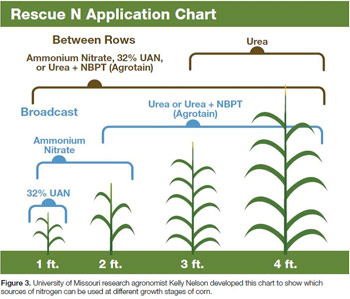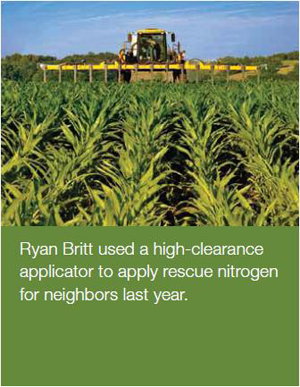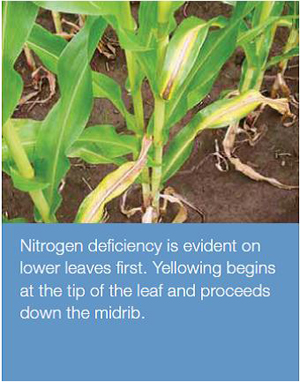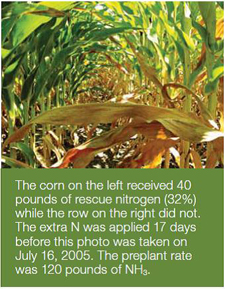
In really wet years, a lot of preplant nitrogen (N) is lost.Wet weather causes N losses somewhere virtually every year. In 2008 and 2009, very wet weather caused major N losses in a huge chunk of the Corn Belt. “My rule of thumb is that more than 16 inches of rain from April through June — or more than a foot in May and June — will lead to N deficiency problems in a substantial number of cornfields,” says University of Missouri agronomist Peter Scharf.
According to Scharf, in 2009 nearly all of Missouri, Arkansas, Kentucky and Tennessee, plus most of Illinois, southern Indiana, and eastern Kansas all had over 16 inches of rain from April through June. In 2008, nearly all of Iowa and Missouri, plus southern Illinois, southern Indiana, southern Wisconsin, eastern Nebraska, eastern Kansas and southeastern Minnesota received over 16 inches of rain during those three crucial months.

“The level of risk depends on N fertilizer management and soil properties as well as rainfall,” says Scharf. “Among preplant application strategies, spring application of anhydrous ammonia has the lowest risk of N loss. But any N-management strategy can be overwhelmed by weather.”
Scharf developed a Nitrogen Loss Scoresheet to help growers identify fields apt to respond to rescue N based on N source, date applied, soil type and degree of wetness.
Farmers who went through back-to-back wet years have been concerned that the wet fall and winter of 2009-10 was setting the stage for another year of N and yield losses.
“My firm belief after the last two years is that every producer and every retail organization need to have a plan for making rescue N applications in place before the season starts,” says Scharf. “Rescue applications of N fertilizer can be highly profitable when earlier N applications have been lost due to wet weather.”
Scharf cites the experience of Wayne Flanary, a University of Missouri agronomy specialist in northwest Missouri. Flanary applied 180 pounds of N as anhydrous ammonia in late-November 2008. Nevertheless, corn in a low area appeared to lack N early in the 2009 growing season. Where Flanary applied an additional 60 pounds of N as dry urea in June, the corn yielded 200 bushels per acre (bu/A). Where he applied an additional

120 pounds of N as urea, the corn yielded 220. Where he didn’t apply any rescue N, it yielded 170 bu/A. Aerial photographs are Scharf’s first choice for diagnosing N deficiency. “You can get through all your acres much more quickly and thoroughly based on aerial photos than by ground-based inspection,” he says.
“At fairly early stages (knee high), aerial photos can help you identify likely problem areas but should be ground-truthed. At later stages (waist high or taller), aerial photos provide reliable indicators of which areas are experiencing N stress and how severe it is,” Scharf says.
“My research suggests that aerial photographs can be translated into yield loss maps that make it easier to decide how much can be spent to correct the problem,” says Scharf. “Aerial photographs can also be translated into variable-rate N maps that can be plugged into a variable-rate applicator. Nitrogen loss is nearly always patchy, resulting in some areas that need rescue N and other areas that don’t.”
In the absence of aerial images, you can tell a lot about corn’s N situation simply by inspecting your fields.
“The appearance of the corn crop is an excellent diagnostic tool,” says Scharf. “Corn that is light green or yellow-green is N-deficient nearly 100 percent of the time in Missouri. However, corn growing in waterlogged soil will be N-deficient even if the N has not been lost. This makes correct diagnosis more difficult. Sometimes this yellow corn will green up when the soil dries out, and no additional N is needed. By the time you’ve been able to walk through the field for a week, the corn should look substantially better if the N is still in the soil. If not, a rescue N application is called for.”

Several different sources of N can be used for rescue applications. Corn height and application method must be considered when determining which N source to use.
University of Missouri research agronomist Kelly Nelson developed the Rescue N Application Chart (shown above) based on research by several agronomists. Scharf says some people are skeptical about recovering yield once corn has been substantially stressed by lack of N.
“My experience and research show that corn has great capacity to use rescue N to produce additional yield until at least silking,” Nelson says. “Research by others suggests that this capacity extends at least a week and probably usually two weeks past silking.”
High-clearance applicators, which are becoming increasingly common, enable growers to dribble or inject liquid N between the rows of tall corn. Ryan Britt of Clifton Hills in north-central Missouri applied rescue N for several neighbors last year with the Hagie applicator shown on the opening page. Britt farms with his father, Randy, and grandfather, Wayne.
Concerned about the risk of losing preplant N, they switched to split applications of N in 2008. Last year, they applied 60 pounds of N preplant then side-dressed in June using N sensors to adjust the rate on-the-go.
Source: Rich Fee, Crops and Soils Editor, Successful Farming